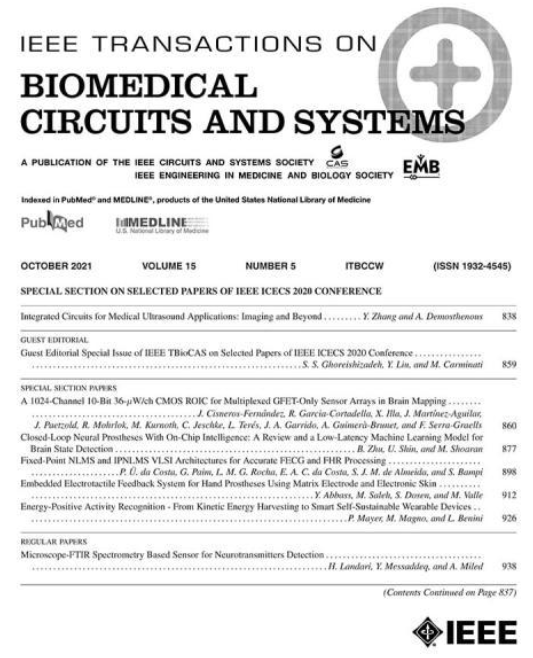在ADC内直接实现矩阵乘法实现低能量分类系统
IF 4.9
2区 医学
Q2 ENGINEERING, BIOMEDICAL
IEEE Transactions on Biomedical Circuits and Systems
Pub Date : 2015-12-28
DOI:10.1109/TBCAS.2015.2500101
引用次数: 34
摘要
在可穿戴和植入式医疗传感器应用中,低能量分类系统对于在设备内部局部获得高质量推断非常重要。鉴于传感器仪表通常随后进行a - d转换,本文提出了一种系统实现,其中分类所需的大部分计算都在ADC内实现。为了实现这一点,首先提出了一种将线性特征提取和分类结合到单个矩阵变换中的算法公式。其次,提出了一种矩阵乘法ADC (MMADC),它可以在模拟输入样本和数字乘法器之间进行乘法,而a - d转换所需的额外能量可以忽略不计。两个系统映射到MMADC展示:(1)基于心电图的心律失常检测器;(2)基于图像像素的人脸性别检测器。所有执行的乘法的均方根误差,归一化为理想乘法结果的均方根误差为0.018。此外,与传统系统的理想版本相比,在达到类似性能水平的情况下,所获得的能源节省估计分别为13倍和29倍。本文章由计算机程序翻译,如有差异,请以英文原文为准。
Realizing Low-Energy Classification Systems by Implementing Matrix Multiplication Directly Within an ADC
In wearable and implantable medical-sensor applications, low-energy classification systems are of importance for deriving high-quality inferences locally within the device. Given that sensor instrumentation is typically followed by A-D conversion, this paper presents a system implementation wherein the majority of the computations required for classification are implemented within the ADC. To achieve this, first an algorithmic formulation is presented that combines linear feature extraction and classification into a single matrix transformation. Second, a matrix-multiplying ADC (MMADC) is presented that enables multiplication between an analog input sample and a digital multiplier, with negligible additional energy beyond that required for A-D conversion. Two systems mapped to the MMADC are demonstrated: (1) an ECG-based cardiac arrhythmia detector; and (2) an image-pixel-based facial gender detector. The RMS error over all multiplication performed, normalized to the RMS of ideal multiplication results is 0.018. Further, compared to idealized versions of conventional systems, the energy savings obtained are estimated to be 13× and 29×, respectively, while achieving similar level of performance.
求助全文
通过发布文献求助,成功后即可免费获取论文全文。
去求助
来源期刊

IEEE Transactions on Biomedical Circuits and Systems
工程技术-工程:电子与电气
CiteScore
10.00
自引率
13.70%
发文量
174
审稿时长
3 months
期刊介绍:
The IEEE Transactions on Biomedical Circuits and Systems addresses areas at the crossroads of Circuits and Systems and Life Sciences. The main emphasis is on microelectronic issues in a wide range of applications found in life sciences, physical sciences and engineering. The primary goal of the journal is to bridge the unique scientific and technical activities of the Circuits and Systems Society to a wide variety of related areas such as: • Bioelectronics • Implantable and wearable electronics like cochlear and retinal prosthesis, motor control, etc. • Biotechnology sensor circuits, integrated systems, and networks • Micropower imaging technology • BioMEMS • Lab-on-chip Bio-nanotechnology • Organic Semiconductors • Biomedical Engineering • Genomics and Proteomics • Neuromorphic Engineering • Smart sensors • Low power micro- and nanoelectronics • Mixed-mode system-on-chip • Wireless technology • Gene circuits and molecular circuits • System biology • Brain science and engineering: such as neuro-informatics, neural prosthesis, cognitive engineering, brain computer interface • Healthcare: information technology for biomedical, epidemiology, and other related life science applications. General, theoretical, and application-oriented papers in the abovementioned technical areas with a Circuits and Systems perspective are encouraged to publish in TBioCAS. Of special interest are biomedical-oriented papers with a Circuits and Systems angle.
 求助内容:
求助内容: 应助结果提醒方式:
应助结果提醒方式:


